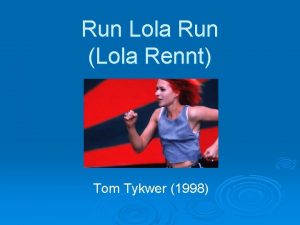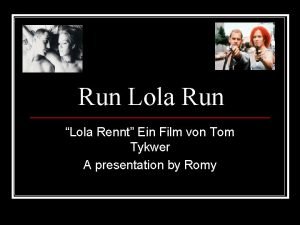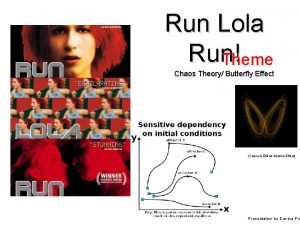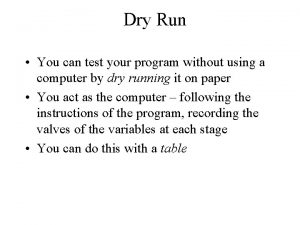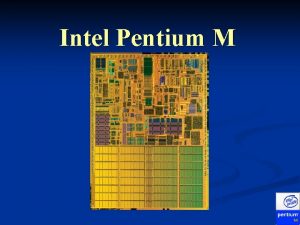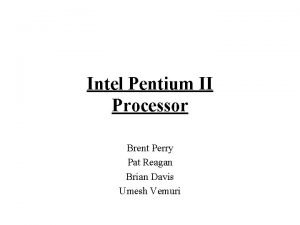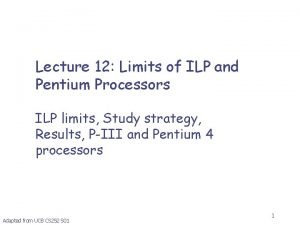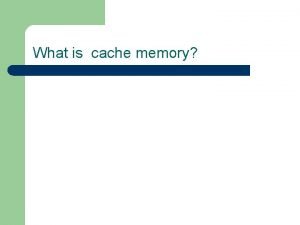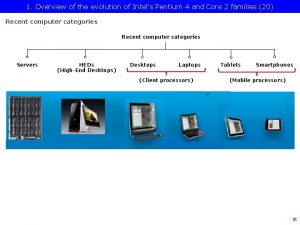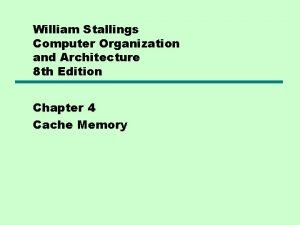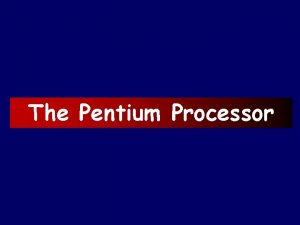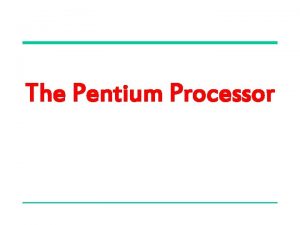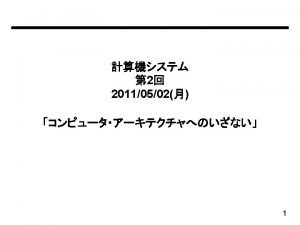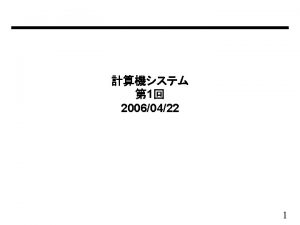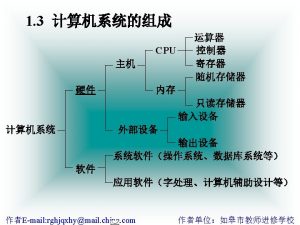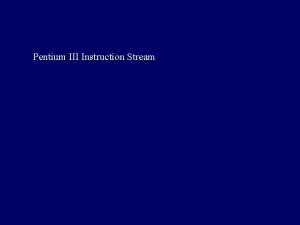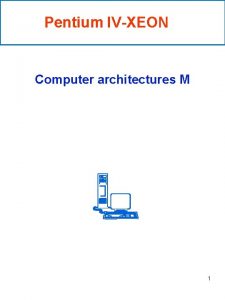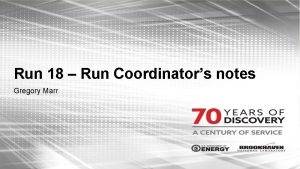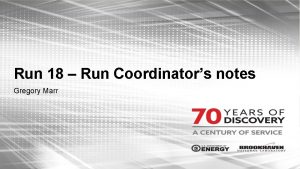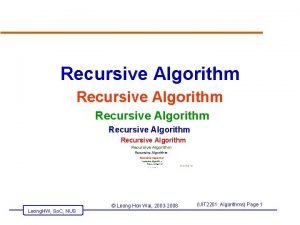Computational Experiments Algorithm run on a Pentium IV




















- Slides: 20

Computational Experiments • Algorithm run on a Pentium IV 2. 4 GHz • Instances from “Rete Ferroviaria Italiana” • For each station: - minimum interval between 2 arrivals = 4 minutes - minimum interval between 2 departures = 2 minutes • Comparison with the currently used “manual” solution

• Profit of train j = πj – αj vj – βj uj (uj and vj in minutes) • The “shift” and the “stretch” penalties are linear in the shift vj and in the stretch uj , respectively Train Type πj αj βj Eurostar 200 7 10 Euronight 150 7 10 Intercity 120 6 9 Combined 110 6 9 Express 110 5 8 Direct 100 5 8 Local 100 5 6 Freight 90 2 3


Characteristics of the instances considered Instance First Station Last Station # stations # trains Ideal profit PC-BO-a Piacenza Bologna 17 221 25740 PC-BO-b Piacenza Bologna 17 40 4800 BRN-BO Brennero Bologna 48 54 5470

Results for the basic problem (Lagr. Heur. ) PC-BO-a (221) PC-BO-b (40) BRN-BO (54) 19830 3181 3332 Scheduled trains 186 32 44 Average shift (minutes) 1. 8 4. 3 2. 0 Average stretch (minutes) 1. 6 1. 5 2. 6 Objective function Manual Solution Objective function Optimized Solution 21250 (7. 2%) 3593 (13. 0%) 4222 (26. 7%) Scheduled trains 192 (3. 2%) 34 (6. 2%) 48 (9. 0%) Average shift (minutes) 1. 1 (38. 8%) 3. 2 (25. 6%) 1. 2 (40. 0%) Average stretch (minutes) 0. 5 (68. 7%) 1. 0 (33. 3%) 1. 2 (53. 8%) CPU time (seconds) 479 43 59

Additional Characteristics • Fixed block signalling – The line is divided into block sections of predetermined length – Each block section is occupied by at most one train at a time – Short sections are designed to increase line capacity, particularly in high density areas and where speeds are lower • Moving block signalling – The position of each train is known continuously by a control center, that takes care of the regulation of the relative distances – Modern technology that requires an efficient communication system between line signals, cabs and control centers

Results with fixed block signalling PC-BO-a (221) PC-BO-b (40) 13809 2541 2486 Scheduled trains 127 26 33 Average shift (minutes) 3. 9 5. 8 4. 5 Average stretch (minutes) 1. 7 2. 5 0. 6 Objective function Manual Solution Objective function Optimized Solution 15186 (10. 0%) BRN-BO (54) 2957 (16. 4%) 3075 (23. 7%) Scheduled trains 133 (4. 7%) 28 (7. 7%) 36 (9. 0%) Average shift (minutes) 2. 0 (48. 7%) 3. 8 (34. 5%) 3. 2 (28. 8%) Average stretch (minutes) 0. 9 (47. 0%) 1. 9 (24. 0%) 0. 0 (100. 0%) 650. 0 29 128 CPU time (seconds)

Additional Characteristics (2) • Capacities of the Stations • The maximim number of trains that can be simultaneously present in each station is given • Computational experiments: - capacity = 2 in the major stations - capacity = 1 in the minor stations

Results with station capacities PC-BO-a (221) PC-BO-b (40) 16806 2784 3252 Scheduled trains 150 27 40 Average shift (minutes) 2. 4 4. 7 3. 1 Average stretch (minutes) 1. 4 0. 7 0. 9 Objective function Manual Solution Objective function Optimized Solution 17506 (8. 8%) BRN-BO (54) 3291 (18. 2%) 4055 (24. 7%) 29 (7. 4%) 43 (7. 5%) Scheduled trains 155 (3. 3%) Average shift (minutes) 1. 6 (33. 3%) 2. 0 (57. 4%) 1. 4 (19. 0%) Average stretch (minutes) 0. 6 (57. 1%) 0. 6 (14. 3%) 0. 0 (100. 0%) CPU time (seconds) 638 32 167

Lagr UB Instances PC-BO-1 Value LP UB sec Value sec 24243 671 23894 814 10953 79 10914 5 7235 88 7200 5 4314 82 4091 16 5032 57 4894 16 16152 315 16102 11 5850 434 5823 27 (221, 17) PC-BO-2 (93, 17) PC-BO-3 (60, 17) PC-BO-4 (40, 17) MU-VR (54, 48) BZ-VR (128, 27) CH-RM (41, 102)

Lagr. Heur. Instances Value LP Heur sec Value sec PC-BO-1 21519 671 21836 34489 PC-BO-2 10861 79 10882 982 PC-BO-3 7148 88 7151 633 PC-BO-4 3603 82 3779 2529 MU-VR 4055 149 4230 5612 BZ-VR 15993 315 15622 5911 CH-RM 5560 434 5547 3963 BN-BO 6761 143 6753 683 CH-MI 20716 256 20977 26639 1684 20 1684 32 MO-MI-1

Addition of new train paths to an existing timetable (operational scenario) Example: single one-way track Kufstein – Verona: number of stations: 56 (345 km) - number of already scheduled trains: 230 (passenger trains 116, freight trains 114) - time frame period: from 00: 00 to 23: 59

Addition of new freight train paths to an existing timetable (Kufstein- Verona): Example 1) number of requested train paths: 24 (requested departure times with a delay of 5 minutes with respect to an existing path; conflicts among the new paths) maximum shift for each requested train = 10 min maximum stretch = 15 min: # scheduled trains = 11 maximum stretch = 20 min: # scheduled trains = 17 maximum stretch = 25 min: # scheduled trains = 20 maximum stretch = 30 min: # scheduled trains = 22 Running time 18 seconds

Addition of new freight train paths to an existing timetable (Kufstein- Verona): Example 2) number of requested train paths: 24 (requested departure times at 00: 00, 01: 00, …, 23: 00) maximum shift for each requested train = 10 min maximum stretch = 15 min: # scheduled trains = 11 maximum stretch = 20 min: # scheduled trains = 15 maximum stretch = 25 min: # scheduled trains = 19 maximum stretch = 30 min: # scheduled trains = 21 Running time 11 seconds

Addition of new freight train paths to an existing timetable (Kufstein- Verona): Example 3) number of requested train paths: 48 (requested departure times at 00: 00, 00: 30, 01: 00, …, 23: 30) maximum shift for each requested train = 10 min maximum stretch = 15 min: # scheduled trains = 25 maximum stretch = 20 min: # scheduled trains = 33 maximum stretch = 25 min: # scheduled trains = 39 maximum stretch = 30 min: # scheduled trains = 45 Running time 13 seconds

Railway Network The considered Railway Network is composed by: • the single one-way corridor Kufstein – Verona Porta Nuova • the corridor Verona Porta Nuova – Bologna (which presents doubleway line segments) • the railway node of Bologna • the alternative routes from Bologna to Rome (Florence and Falconara) • the railway node of Florence • the different possible routes from Florence to Rome ( “direttissima”, i. e. the fast line and, “lenta”, i. e. the slow line) • the railway node of Rome

We start with a feasible timetable with 679 fixed trains and evaluate two different cases of adding new freight trains: • 24 trains, one each hour • 48 trains, one each half an hour For both cases, we consider two different possibilities: • forbid the alternative slow route (Falconara route) • allow to use the slow route (Falconara route) Moreover, we consider different values of the maximum stretch.

The table shows the number of scheduled trains if the Falconara route cannot be used. Name max str 20 min max str 30 min max str 45 min 24 trains 13 21 22 48 trains 29 43 46

The table shows the number of scheduled trains if the Falconara route is allowed. Name max str 20 min max str 30 min max str 45 min 24 trains 16 22 24 48 trains 32 46 48

Overall Advantages of the Optimization Algorithms • Much faster response time with respect to “manual” methods, with the possibility to try several different scenarios • Improvement of the solution quality with respect to “manual” methods • Satisfaction of a larger number of TO requests • Possibility to handle more than one request in “real time”
 Pentium pipeline stages
Pentium pipeline stages Long run in perfect competition
Long run in perfect competition Run lola run editing techniques
Run lola run editing techniques Lola brigitta
Lola brigitta Short run vs long run economics
Short run vs long run economics Run lola run wiki
Run lola run wiki Short run equilibrium under perfect competition
Short run equilibrium under perfect competition Multirule
Multirule Run lola run theme
Run lola run theme Dry run algorithm
Dry run algorithm Dry run table
Dry run table Fast desktop for architecture software
Fast desktop for architecture software Historia intel
Historia intel Intel pentium history
Intel pentium history Intel pentium
Intel pentium Intel pentium processor
Intel pentium processor 1993 pentium processor
1993 pentium processor Pentium 4 block diagram
Pentium 4 block diagram Pentium iii
Pentium iii Pentium evolution
Pentium evolution Pentium 4 cache organization
Pentium 4 cache organization


